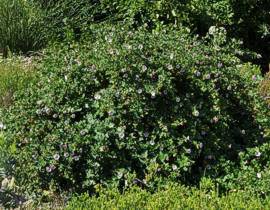Anisodontea scabrosa
Anisodontea scabrosa (L.) Bates
Family: Malvaceae
Common names: rough-leaf African mallow, sand rose, pink mallow, hairy mallow (Eng.); sandroos, pienk-kiesieblaar, harigemalva (Afr.)
Introduction

Who can resist a bright cheerful shrub that flowers throughout the year? This mallow is ideally suited for home gardens being able to withstand coastal conditions and frost.
Description
Description
Anisodontea scabrosa is an evergreen perennial shrub of variable size but reaching heights of 2-3m. It has an upright branching habit with partially woody stems.
The aromatic leaves are soft with prominent veins, stiff hairs and are often sticky. The leaves are variable in shape mostly 3 lobed or elliptic and toothed; 20 - 70mm long.

Open, hibiscus-like blooms are light to dark pink 20 - 25mm in diameter; flowering all year but mostly during spring and early summer (September to December).
The fruit is 9-15 chambered, dry and dehiscent (opens spontaneously when ripe) producing small black seeds.
Conservation Status
Status
Anisodontea scabrosa has a wide distribution and is commonly found. Its status is therefore considered Least Concern.
Distribution and habitat
Distribution description
Indigenous to South Africa's winter rainfall areas, they are found widely distributed in sunny, sheltered, bushy places along the coast from Saldanha Bay, around the Cape Peninsula up to the Eastern Cape and KwaZulu-Natal. Anisodontea scabrosa grows in diverse soils, often in disturbed ground but chiefly on coastal sands at low altitudes. They are hardy plants able to withstand frost.
Derivation of name and historical aspects
History
The name Anisodontea comes from the Greek aniso, referring to the leaves which are unevenly toothed. The species name scabrosa is derived from the Latin scaber, meaning rough to the touch, as felt in the harshly hairy leaves. The family Malvaceae has many important commercial agricultural crops including cotton (Gossypium), cacao and kenaf (stokroos in Afrikaans) which is cultivated for its fiber in many countries including South Africa. Well known garden shrubs such as Hibiscus and Abutilon are included in the family.
There are 21 species of Anisodontea in South Africa, predominantly in the karoo and fynbos.
Ecology
Ecology
Anisodontea scabrosa is sticky and smells of tar - for these reasons it is said to be unpalatable to grazing animals and preying insects (W.P.U Jackson, 1980). Honey bees and carpenter bees frequent the flowers.
Uses
Use
Use as a decorative garden plant. It is a rewarding shrub for the home garden with year round blossoms. Plants respond well to pruning and long shoots can be trained into standards or topiary. Very suitable for growing as a pot plant and they can be used as bonsai specimens.

Growing Anisodontea scabrosa
Grow
Excellent for the indigenous garden, Anisodontea scabrosa can form a delightful informal hedge in a cottage-style garden with its showy pink flowers and fresh green foliage. In a more formal setting they can be clipped to shape.
Grow from either seed sown in autumn; or tip and stem cuttings taken in spring and summer once the new shoots have become semi-hard. Use a well drained sandy soil medium. Transplant young plants before the new seasons growth; they do not handle too much disturbance at a later stage.
As in the wild, it should be grown in a well drained, warm, sunny spot with free air flow. They do not favour humid climates with hot wet summers. Should the plants not be well aired, white-fly may become a possible pest.
They tolerate light shade, but flower better in full sun. Feed with a slow release 3.1.5 for vigorous growth and water regularly throughout summer to promote abundant flowering. Being frost tolerant they are able to grow away from the coast.
References
- Bean, A. & Johns, A. 2005. Stellenbosch to Hermanus. South African Wild Flower Guide 5. Botanical Society of South Africa, Cape Town.
- Jackson, W.P.U. 1980. Wild Flowers of the Fairest Cape. Howard Timmins Publishers, Cape Town.
- http://en.wikipedia.org/wiki/Malvaceae http://en.wikipedia.org/wiki/Kenaf
- Leistner, O.A. (ed.). 2000. Seeds plants of southern Africa: families and genera. Strelitzia 10. National Botanical Institute, Pretoria.
- Nichols, G. 2008.The mallow that's pretty in pink (Anisodontea scabrosa): the indigenous garden. Farmer's Weekly. March 2008.
- Trinder-Smith, T., Maytham Kidd, M. & Anderson, F. 2006. Wild Flowers of the Table Mountain National Park. South African Flower Guide 12. Botanical Society of South Africa, Cape Town.
Credits
Nicolette Stoll
Millennium Seed Bank Project
May 2011
Plant Attributes:
Plant Type: Shrub
SA Distribution: Eastern Cape, KwaZulu-Natal, Northern Cape, Western Cape
Soil type: Sandy, Clay, Loam
Flowering season: Spring, Early Summer, Winter
PH: Acid, Alkaline, Neutral
Flower colour: Purple, Pink
Aspect: Full Sun
Gardening skill: Average
Special Features:
Horticultural zones











Rate this article
Article well written and informative
Rate this plant
Is this an interesting plant?
Login to add your Comment
Back to topNot registered yet? Click here to register.